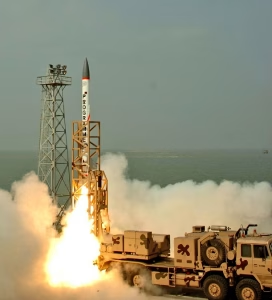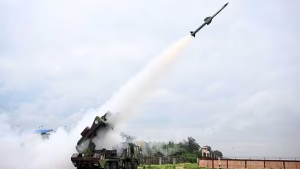Odisha – India Tests Air Defense Systems in a groundbreaking demonstration off the Odisha coast, marking a significant milestone in the country’s defense capabilities. The Defence Research and Development Organisation (DRDO) successfully conducted the maiden flight tests of the Integrated Air Defence Weapon System (IADWS) on Saturday, showcasing the nation’s advancing military technology prowess.
Multi-Target Destruction Achievement

The historic moment when India Tests Air Defense Systems involved the simultaneous engagement and complete destruction of three different targets at varying altitudes and ranges. This comprehensive test demonstrated the system’s capability to handle multiple aerial threats simultaneously, a crucial requirement for modern warfare scenarios.
During the test where India Tests Air Defense Systems, the targets included two high-speed fixed-wing unmanned aerial vehicle targets and a multi-copter drone. The successful elimination of these diverse threats showcased the system’s versatility in countering different types of aerial attacks that modern military forces might encounter.
Advanced Multi-Layered Defense Architecture

The IADWS represents a sophisticated approach when India Tests Air Defense Systems, incorporating multiple weapon platforms in a unified framework. The system consists of Quick Reaction Surface-to-Air Missiles (QRSAM), Very Short Range Air Defence System (VSHORADS), and a laser-based directed energy weapon, creating comprehensive coverage against aerial threats.
This multi-layered approach ensures that when India Tests Air Defense Systems, different weapon systems can engage targets at their optimal ranges and altitudes. The integration of conventional missile systems with cutting-edge laser technology positions India among an exclusive group of nations possessing such advanced defensive capabilities.
Centralized Command and Control Excellence
The success achieved when India Tests Air Defense Systems relies heavily on the centralized command and control centre developed by Defence Research and Development Laboratory, Hyderabad. This sophisticated control system coordinates the integrated operation of all weapon system components, ensuring seamless engagement of multiple targets simultaneously.
The centralized architecture demonstrated when India Tests Air Defense Systems allows for rapid threat assessment, target prioritization, and weapon allocation decisions. This unified command structure eliminates coordination delays that could prove fatal in real combat scenarios where split-second decisions determine mission success.
Mission Sudarshan Chakra Context


The timing of when India Tests Air Defense Systems aligns perfectly with Prime Minister Narendra Modi’s announcement of Mission Sudarshan Chakra during his Independence Day speech. This ambitious initiative sets a 10-year deadline for developing an indigenous air defense shield integrated with offensive weapons, fundamentally transforming India’s defense posture.
Also Read: India Suspends Postal Service To US: Shocking Response to Trump’s Tariff War
The successful test where India Tests Air Defense Systems represents the initial implementation of Modi’s vision for a “formidable military capability to defend India’s military and civilian installations against aerial attacks.” The Prime Minister’s reference to Lord Krishna’s Sudarshan Chakra from the Mahabharata emphasizes the system’s dual defensive and offensive capabilities.
Laser Weapon Technology Breakthrough
A significant achievement when India Tests Air Defense Systems includes the successful deployment of high-energy laser weapons. In April, India had previously tested locally produced laser weapons, demonstrating capabilities to destroy fixed-wing drones at long range, swarm drones, and surveillance equipment.
The inclusion of laser systems when India Tests Air Defense Systems places India in an exclusive league with only a few countries possessing such technology. The United States, Russia, China, the United Kingdom, Germany, and Israel are among the select nations that have mastered directed energy weapons for military applications.
Operational Validation Through Real Combat


The practical effectiveness demonstrated when India Tests Air Defense Systems builds upon proven combat performance during Operation Sindoor. The Akashteer air defense control and reporting system emerged as the centerpiece of India’s air defense grid during New Delhi’s direct military action against Pakistan following the April 22 Pahalgam terror strike.
During the four-day conflict that validated systems before India Tests Air Defense Systems in this configuration, Akashteer successfully punctured multiple waves of Pakistani aerial attacks. The system guaranteed prompt detection and targeting of incoming threats, proving its combat worthiness under real battlefield conditions.
Comprehensive Target Engagement Success
The flawless performance when India Tests Air Defense Systems was confirmed by range instruments deployed by the Integrated Test Range, Chandipur. All weapon system components, including missile systems, drone detection and destruction systems, command and control systems, communication networks, and radars performed without error.
Defense Minister Rajnath Singh praised the achievement when India Tests Air Defense Systems, stating that this unique flight test has established the multi-layered air-defense capability of the country. He emphasized that the successful demonstration will strengthen area defense for important facilities against enemy aerial threats.
Future Defense Capability Expansion


The success achieved when India Tests Air Defense Systems represents just the beginning of a comprehensive modernization program. Prime Minister Modi’s vision extends to 2035, encompassing expansion, strengthening, and modernization of the national security shield over the next decade.
This ambitious timeline following the success when India Tests Air Defense Systems indicates sustained investment in indigenous defense technology development. The integration of the IADWS with existing systems like the Indian Air Force’s Integrated Air Command and Control System (IACCS) creates a robust, four-tiered air defense shield protecting critical national assets from diverse aerial threats.

